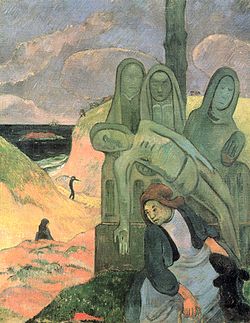
Synthetism is a term used by post-Impressionist artists like Paul Gauguin, Émile Bernard and Louis Anquetin to distinguish their work from Impressionism. Earlier, Synthetism has been connected to the term Cloisonnism, and later to Symbolism. The term is derived from the French verb synthétiser.
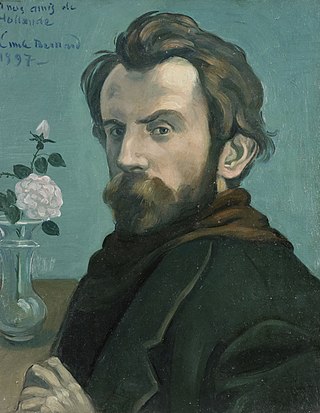
Émile Henri Bernard was a French Post-Impressionist painter and writer, who had artistic friendships with Vincent van Gogh, Paul Gauguin and Eugène Boch, and at a later time, Paul Cézanne. Most of his notable work was accomplished at a young age, in the years 1886 through 1897. He is also associated with Cloisonnism and Synthetism, two late 19th-century art movements. Less known is Bernard's literary work, comprising plays, poetry, and art criticism as well as art historical statements that contain first-hand information on the crucial period of modern art to which Bernard had contributed.

Charles Laval was a French painter associated with the Synthetic movement and Pont-Aven School.

Pont-Aven is a commune in the Finistère department in the Brittany region in Northwestern France.

Pont-Aven School encompasses works of art influenced by the Breton town of Pont-Aven and its surroundings. Originally the term applied to works created in the artists' colony at Pont-Aven, which started to emerge in the 1850s and lasted until the beginning of the 20th century. Many of the artists were inspired by the works of Paul Gauguin, who spent extended periods in the area in the late 1880s and early 1890s. Their work is frequently characterised by the bold use of pure colour and their Symbolist choice of subject matter.

The Yellow Christ is a painting executed by Paul Gauguin in 1889 in Pont-Aven. Together with The Green Christ, it is considered to be one of the key works of Symbolism in symbolic mythological paintings of the older era as represented by Symbolism.

Meijer Isaac de Haan was a Dutch painter. In French the name was written Meyer de Haan.

Vision after the Sermon (Jacob Wrestling with the Angel) is an oil painting by French artist Paul Gauguin, completed in 1888. It is now in the Scottish National Gallery, Edinburgh. It depicts a scene from the Bible in which Jacob wrestles an angel. It depicts this indirectly, through a vision that the women depicted see after a sermon in church. It was painted in Pont-Aven, Brittany, France.

The Musée des Beaux Arts de Pont-Aven also known as Museum of Pont-Aven was created in 1985 with the support of the French Museum Department and the Finistère Conseil Général. The modern wing built in 1985 is reserved for exhibitions and the old wing, which was renovated in 1987, houses a historical reconstruction of Pont-Aven at the end of the 19th century as well as the permanent collection dedicated to the Pont-Aven School.

Breton Women at a Wall is an oil painting by Émile Bernard. It is part of the permanent collection of the Indianapolis Museum of Art.

Charles Filiger was a French Symbolist painter. He was one of the artists who associated with Gauguin at Pont-Aven in Brittany.
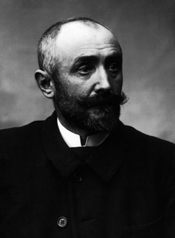
Henry Moret was a French Impressionist painter. He was one of the artists who associated with Paul Gauguin at Pont-Aven in Brittany. He is best known for his involvement in the Pont-Aven artist colony and his richly colored landscapes of coastal Brittany.
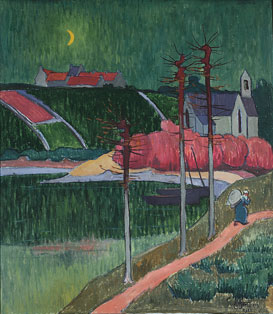
Émile Jourdan was a French painter who became one of the artists who gathered in the village of Pont-Aven in Brittany.
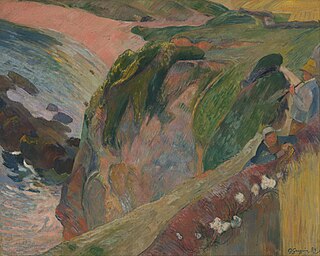
The Flageolet Player on the Cliff is an 1889 oil painting by French artist Paul Gauguin, located in the Indianapolis Museum of Art, which is in Indianapolis, Indiana. It depicts a Breton couple on a narrow path precipitously overlooking the Atlantic.

Self-Portrait with Halo and Snake, also known as Self-Portrait, is an 1889 oil-on-wood painting by French artist Paul Gauguin, which represents his late Brittany period in the fishing village of Le Pouldu in northwestern France. No longer comfortable with Pont-Aven, Gauguin moved on to Le Pouldu with his friend and student Meijer de Haan and a small group of artists. He stayed for several months in the autumn of 1889 and the summer of 1890, where the group spent their time decorating the interior of Marie Henry's inn with every major type of art work. Gauguin painted his Self-Portrait in the dining room with its companion piece, Portrait of Jacob Meyer de Haan (1889).

The Talisman is a painting by French artist Paul Sérusier made in 1888, under the guidance of Paul Gauguin at the artist's colony of Pont-Aven in Brittany. Formally known as The Bois d'Amour at Pont Aven, it was called The Talisman and became the starting point and icon of the group of young painters called The Nabis. It was a landmark in early Post-Impressionism, Synthetism, and Cloisonnism. It is now in the Musée d'Orsay in Paris.
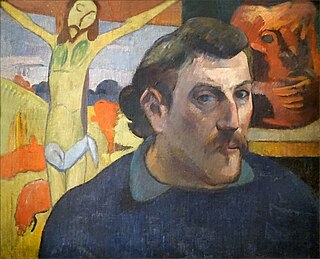
Self-Portrait with the Yellow Christ is an 1890 or 1891 painting by Paul Gauguin, produced in Pont-Aven in Brittany and now in the musée d'Orsay in Paris, to which it was assigned after its purchase by the French state in 1994 with financial assistance from Philippe Meyer and a Japanese patron.

The Pension Gloanec was an inn in Pont-Aven, Brittany, France, that was a base for artists of the Pont-Aven School in the last half of the 19th century. It was known for economical but excellent quality food, where the diners served themselves from shared dishes set out on a long table in the dining room. There were few rooms, so most of the artists boarded elsewhere in the town. Its most famous resident was Paul Gauguin who stayed several times between 1886 and 1894. Today the building houses a bookstore, gallery and exhibition space.
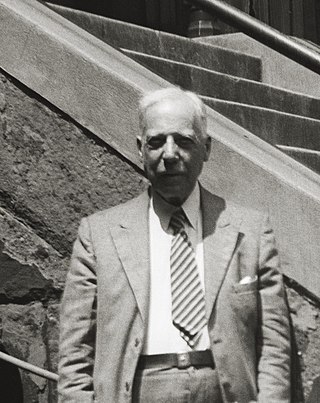
Georges Rasetti was a French Impressionist and Modernist painter and ceramicist who was born in Paris, France. Rasetti began by being a painter of genre and landscapes. In 1886, he married Céline Chaudet, sister of Georges Chaudet, painter, photographer and art dealer for Paul Gauguin. His son, Georges Estrel Rasetti, was also a painter and sculptor.
